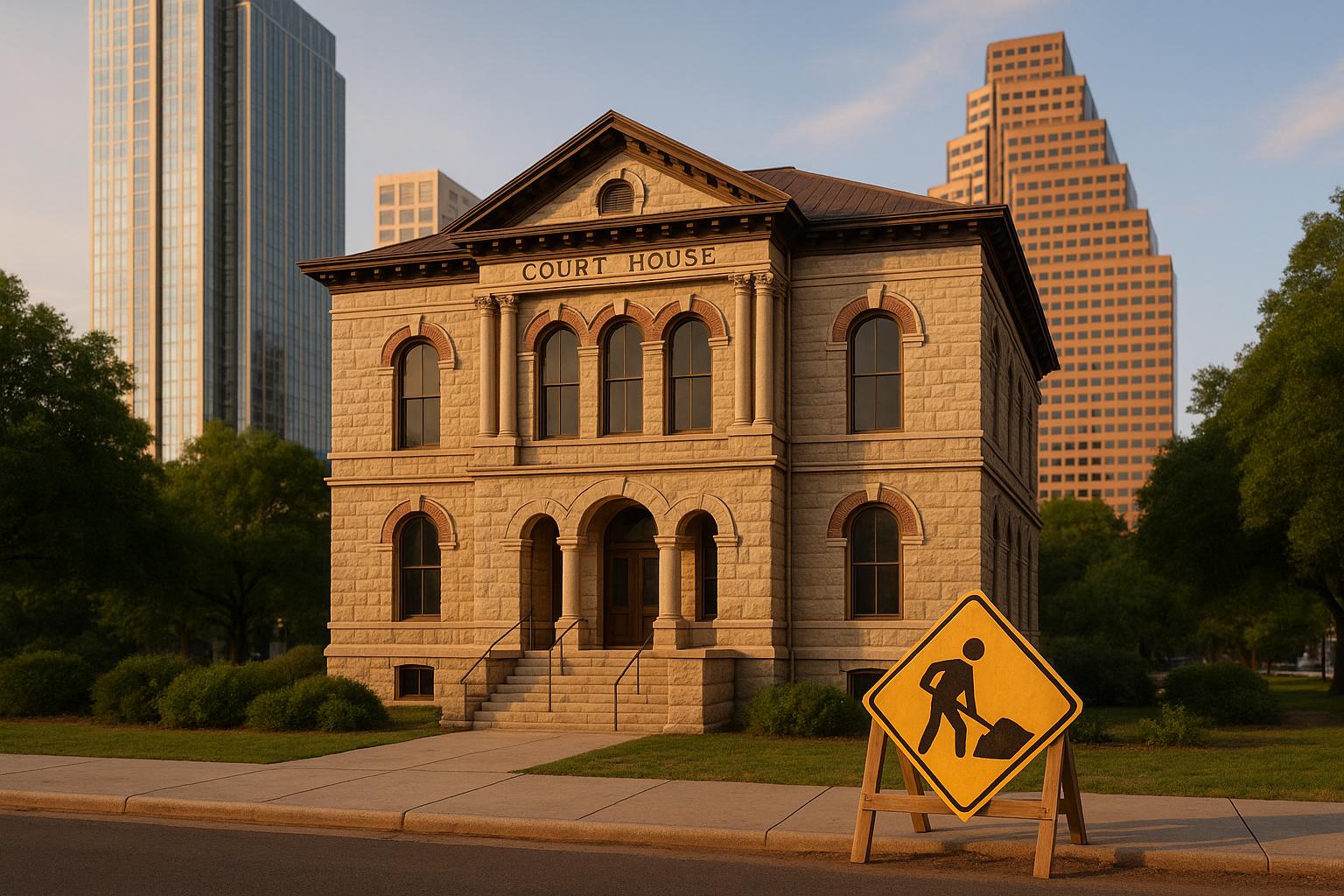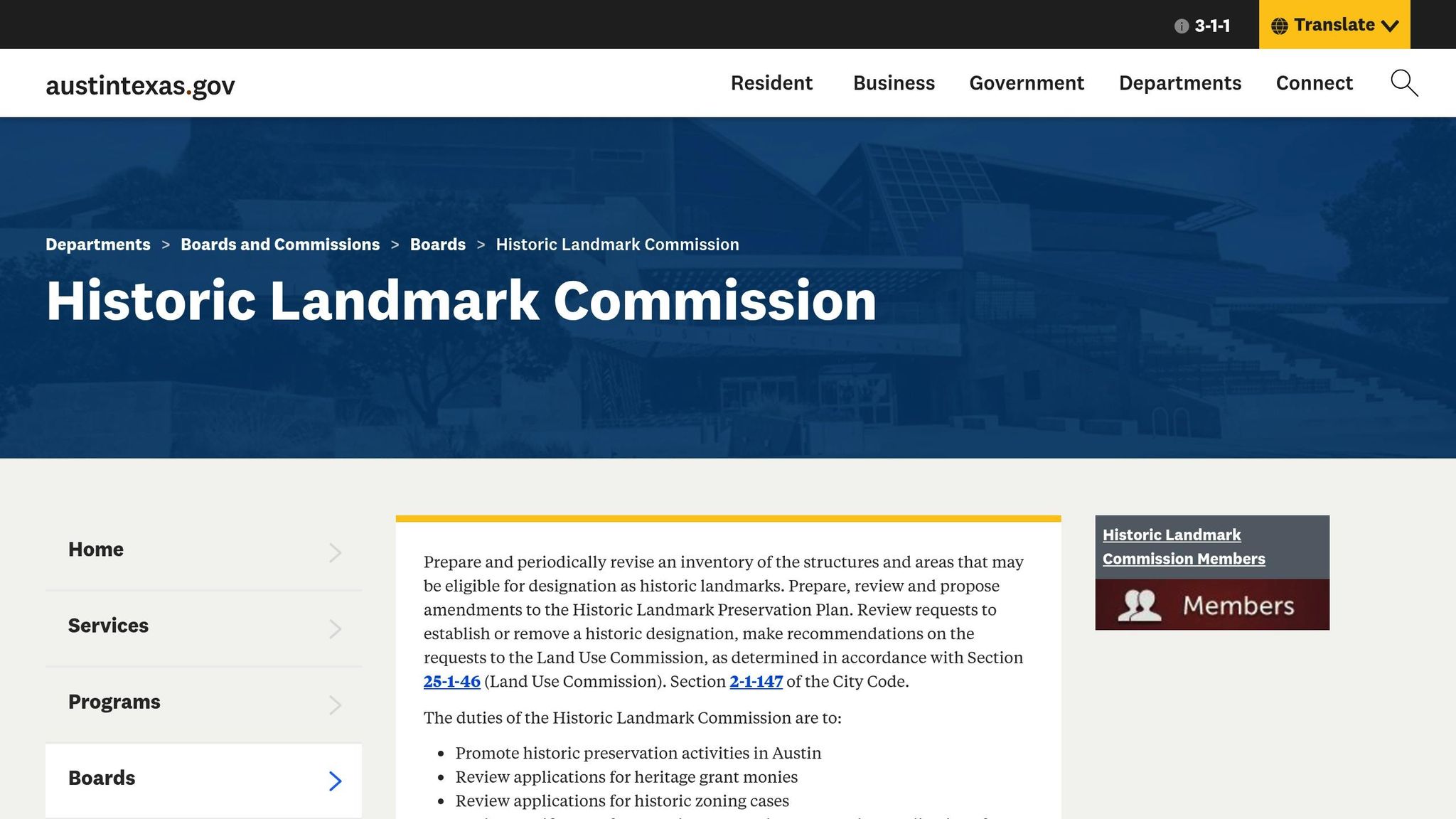Austin’s historic landmarks preserve the city’s past but often lead to legal disputes between property owners and preservation authorities. Key issues include property rights restrictions, impacts on property values, and challenges with renovation or demolition. These conflicts highlight the need for clearer rules and better solutions.
Key Points:
- Property Rights vs. Preservation: Owners face strict rules limiting modifications to historic properties.
- Property Value Impact: Historic designation can both increase appeal or burden owners with extra costs.
- Renovation Challenges: Lengthy approval processes for updates or demolitions create tension.
Austin’s preservation laws, enforced by the Historic Landmark Commission, aim to protect historic sites while offering tax exemptions and mediation options to address disputes. Collaborative efforts, including community input and policy updates, are essential for resolving these conflicts.
East Austin property owners fight historic designation
Key Legal Disputes in Historic Designation
Historic landmark designations in Austin often lead to legal conflicts between property owners and city officials. These disagreements revolve around balancing the preservation of Austin’s heritage with the rights of individual property owners. Here’s a closer look at the key areas of contention: property rights, market effects, and renovation rules.
Property Rights vs. Preservation Rules
When a property is designated as historic, owners face strict rules that limit what they can modify. Many disputes arise over whether these preservation rules unfairly restrict owners from making modern updates, potentially infringing on their property rights.
Impact on Property Values
Historic designation can have mixed effects on property values. Some argue that it boosts a property’s appeal and market standing, while others believe the regulatory costs and higher maintenance demands reduce its competitiveness.
Challenges with Renovation and Demolition
Renovation and demolition rules often require extensive reviews, which can lead to lengthy legal battles. Property owners frequently see these requirements as obstacles to necessary updates, creating tension between maintaining historical integrity and meeting modern needs.
These legal disputes underscore the importance of creating clearer, more practical guidelines that protect Austin’s historical architecture while addressing the concerns of property owners.
Austin’s Historic Preservation Laws
Historic Landmark Commission Powers
The Austin Historic Landmark Commission has the authority to approve or deny exterior alterations, review demolition requests, and recommend historic zoning changes. These decisions are binding unless the City Council overturns them. For instance, in early 2025, the commission denied a demolition request at 7304 Knox Lane and required ground-penetrating radar surveys before any construction near the adjacent spring. These responsibilities align with the city’s broader efforts to protect its historic sites.
Current Preservation Laws
Austin’s preservation efforts combine local ordinances with state laws, specifically Chapter 211 of the Texas Local Government Code, and are further guided by the updated Historic Design Standards introduced in 2023.
Some key regulations include:
| Requirement | Description | Enforcement |
|---|---|---|
| Design Review | Evaluation of windows, materials, and building size | Historic Landmark Commission |
| Mandatory Repairs | Original features must be repaired, not replaced | Fines of up to $2,000 per day |
| Archaeological Protection | Surveys required for construction near springs | Pre-development approval |
These rules form the foundation for many legal disputes. A notable 2024 Texas Supreme Court decision in City of Austin v. Henderson clarified that age alone isn’t enough to deny demolition permits. Properties must demonstrate architectural or historical importance.
Legal Options for Property Owners
For property owners facing disputes over historic designations, there are specific legal avenues available. Owners can appeal a designation to the City Council within 14 days of the commission’s decision. A well-known example is the 2025 Running Rope Ranch case, where owner Jimmy Nasour successfully argued that modifications had diminished the property’s historic value.
"The 2024 compromise on the Clarksville District created a new model for balancing preservation with property rights", said the Austin Historic Preservation Office. "By implementing city-funded preservation easements for 40% of affected properties, we avoided potential takings claims while protecting significant structures."
Austin also offers a historic tax exemption program that includes a 100% exemption on the structure’s value and a 50% exemption on land value, with applications due by January 15 each year. For owners seeking alternatives to formal designation, restrictive covenants may provide more flexibility.
Violations of these laws come with steep penalties. In 2023, unauthorized siding replacement on a Rainey Street property resulted in $45,000 in fines, with repeat offenses subject to double penalties.
sbb-itb-4c99469
How to Resolve Historic Status Disputes
Using Mediation
Mediation plays a key role in addressing disputes over historic property designations in Austin. The process begins with a detailed property review, followed by discussions among stakeholders to find solutions that work for everyone. Local real estate experts often assist property owners in understanding market trends while maintaining the property’s historic character. For example, consulting professionals like those at Austin Local Team can provide insights into preservation rules and current market conditions. Alongside mediation, potential policy adjustments can also help resolve these conflicts.
Suggested Policy Changes
Officials are exploring policy updates to better balance development needs with preservation efforts. Suggestions include requiring waiting periods before demolition permits are approved, offering financial assistance for property maintenance, and creating incentives for repurposing historic structures. These changes aim to give property owners more options while safeguarding Austin’s architectural heritage. Engaging the community in these discussions further ensures these policies address real concerns.
Getting Community Input
Community involvement is crucial for resolving disputes around historic landmarks. Workshops and consultations allow stakeholders to share their views and work toward fair solutions. Including local real estate experts in these discussions can provide a clearer picture of market realities and ensure preservation plans align with community priorities. This open, collaborative approach helps create practical and transparent strategies that reflect what the community values most.
Conclusion: Managing Historic Property Disputes
Key Takeaways
Resolving Austin’s landmark property disputes involves finding a balance between preserving historical landmarks and respecting property owners’ rights. Success hinges on open communication and well-informed decisions that weigh historical significance alongside ownership concerns.
Collaborative Solutions
Effective resolution requires teamwork. Stakeholders can address disputes by:
- Hosting regular community discussions to gather diverse perspectives.
- Consulting local professionals to align preservation efforts with market dynamics.
- Exploring mediation options as an alternative to legal action.
FAQs
What can property owners in Austin do if they disagree with a historic landmark designation?
If a property owner in Austin disagrees with a historic landmark designation, they have several options to address their concerns. First, they can formally appeal the designation through the city’s established processes, which typically involve presenting their case to the Historic Landmark Commission or City Council. This may include providing evidence or arguments to contest the designation.
Additionally, property owners may consult with legal professionals experienced in land use or historic preservation laws to explore further legal avenues. In some cases, negotiating with city officials to reach a compromise or seeking amendments to the designation may also be viable solutions. Understanding the local regulations and working with experts can help navigate these disputes effectively.
How do Austin’s historic preservation laws impact property values, and what financial considerations should owners keep in mind?
Austin’s historic preservation laws can significantly influence property values, often in ways that depend on the specific property and its designation. Properties with historic landmark status may see increased value due to their cultural significance and unique appeal. However, owners should also be aware of potential financial implications, such as restrictions on modifications, which could limit development options and affect resale value.
For property owners, it’s essential to weigh the benefits of preservation – like potential tax incentives or grants – against the costs of maintaining compliance with preservation guidelines. Consulting with local experts, such as real estate professionals or preservation specialists, can help you better understand the financial impact of these laws on your property. If you’re navigating these challenges in Austin, Austin Local Team can connect you with experienced agents who specialize in local real estate and can provide valuable insights tailored to your needs.
How does community input influence the resolution of disputes over historic landmarks in Austin?
Community input plays a crucial role in resolving disputes over historic landmark designations in Austin. Residents, property owners, and local organizations often provide valuable perspectives during public hearings and city council meetings, helping to shape decisions that balance preservation with property rights.
By engaging with the community, city officials can better understand concerns, such as the impact on property values or neighborhood development, and work toward solutions that address the needs of all stakeholders. Open dialogue fosters collaboration and ensures that historic preservation efforts align with Austin’s growth and unique character.






